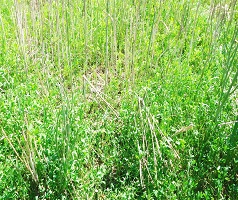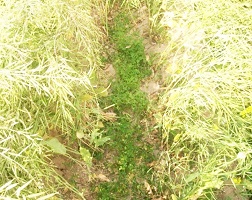
In the pearl millet - mustard cropping system, stovers of pearl millet are used as fodder for animals and mustard stovers are disposed for firing the brick kilns or used as fuel in the rural households. As a consequence, very little organic matter is returned to the soils for building the soil organic carbon, supporting the biotic activities and for replenishing the nutrients removed by the two crops. As a result, the soil organic carbon is reported to decline that causes the problems of soil erosion and soil health. In order to improve the productivity to make it profitable to farmers, it was considered necessary to diversify through the legume crop based relay cropping system in the mustard crop.
To enhance the crops’ yield and income, the demonstrations were conducted of relay cropping of Berseem in mustard in pearl millet based system. The demonstrations were conducted in the selected villages of “Farmers’ First Programme Project” of the Zonal Agricultural Research Station in participatory mode in Morena District of Madhya Pradesh during the Years - 2016-19. The relay cropping of Berseem (Trifolium alexandrinum) was established in standing crop of mustard (Brassica juncea) crop with adopting recommended package of practices of the Vishwa Vidyalaya.
During the rainy (Kharif) season, the crop pearl millet variety - hybrid and mustard variety RH- 749 were established. After the establishment of 30-35 days of mustard, the Berseem (variety - Wardan) was sown by uniform broadcasting of 20 kg/ha seed before the first irrigation of mustard in each year. The seed of Berseem was treated with Captan (2 g/kg seed) followed by the bio-fertilizers, such as, Rhizobium trifoli and Pseudomonas fluorescens.

After the harvesting of mustard, three irrigation at tillering, head formation and seed filling stages were applied. The pod borer (Helicoverpa armigera) was observed as a common polyphagous sporadic pest in Egyptian clover crop in all the years and was controlled through spinosad, sprayed @ 150 ml/ha at an economic threshold level. The matured Berseem fodder crop was harvested from 3rd to 4th week of May in each year.
The results of innovative demonstrations on seed yield of pearl millet and mustard productivity with relay cropping during the 2nd Year onwards increased by 14 to 27% and 11 to 26% as compared to without relay cropping fields. The similar trends of pearl millet equivalent system productivity increased from 50 to 73% with relay cropping as compared with without relay cropping 7.2 t/ha. The cultivation cost in demonstrations of without and with relay cropping were Rs. 57,220 and 76,740/ha, whereas, net returns were Rs. 63,170 and 1,00,670/ha, respectively.
The results of demonstrations of the relaying of Berseem legume cropping in mustard seem to improve the soil fertility through N-fixation, and improvement in SOC through residue as a substrate to microbes to thrive. The availability of macro and micro-nutrients increased due to Berseem residue (1.8-2.2 Ha/Year) retention or incorporated in the plough layer by tillage operations. The inclusion of relay cropping of Berseem crop in the mustard-based system which leaves residues seems to be a very profitable proposition in some groundwater/canal water support.
(Source: ICAR-FFP Project, Rajmata Vijayaraje Scindia Krishi Vishwa Vidyalaya - Zonal Agricultural Research Station, Morena, Madhya Pradesh)








Like on Facebook
Subscribe on Youtube
Follow on X X
Like on instagram